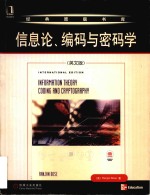图书介绍
Information theorypdf电子书版本下载

- coding and cryptography = 信息论、编码与密码学 (英文版) 著
- 出版社: China Machine Press
- ISBN:7111127706
- 出版时间:2003
- 标注页数:280页
- 文件大小:55MB
- 文件页数:301页
- 主题词:信息论-英文;信息-编码-英文;密码-理论-英文
PDF下载
下载说明
Information theoryPDF格式电子书版下载
下载的文件为RAR压缩包。需要使用解压软件进行解压得到PDF格式图书。建议使用BT下载工具Free Download Manager进行下载,简称FDM(免费,没有广告,支持多平台)。本站资源全部打包为BT种子。所以需要使用专业的BT下载软件进行下载。如 BitComet qBittorrent uTorrent等BT下载工具。迅雷目前由于本站不是热门资源。不推荐使用!后期资源热门了。安装了迅雷也可以迅雷进行下载!
(文件页数 要大于 标注页数,上中下等多册电子书除外)
注意:本站所有压缩包均有解压码: 点击下载压缩包解压工具
图书目录
Part Ⅰ Information Theory and Source Coding 3
1.Source Coding 3
1.1 Introduction to Information Theory 3
1.2 Uncertainty And Information 4
1.3 Average Mutual Information And Entropy 11
1.4 Information Measures For Continuous Random Variables 14
1.5 Source Coding Theorem 15
1.6 Huffman Coding 21
1.7 The Lempel-Ziv Algorithm 28
1.8 Run Length Encoding and the PCX Format 30
1.9 Rate Distortion Function 33
1.10 Optimum Quantizer Design 36
1.11 Introduction to Image Compression 37
1.12 The Jpeg Standard for Lossless Compression 38
1.13 The Jpeg Standard for Lossy Compression 39
1.14 Concluding Remarks 41
Summary 42
Problems 44
Computer Problems 46
2.Channel Capacity and Coding 47
2.1 Introduction 47
2.2 Channel Models 48
2.3 Channel Capacity 50
2.4 Channel Coding 52
2.5 Information Capacity Theorem 56
2.6 The Shannon Limit 59
2.7 Random Selection of Codes 61
2.8 Concluding Remarks 67
Summary 68
Problems 69
Computer Problems 71
Part ⅡError Control Coding(Channel Coding) 75
3.Linear Block Codes for Error Correction 75
3.1 Introduction to Error Correcting Codes 75
3.2 Basic Definitions 77
3.3 Matrix Description of Linear Block Codes 81
3.4 Equivalent Codes 82
3.5 Parity Check Matrix 85
3.6 Decoding of a Linear Block Code 87
3.7 Syndrome Decoding 94
3.8 Error Probability after Coding (Probability of Error Correction) 95
3.9 Perfect Codes 97
3.10 Hamming Codes 100
3.11 Optimal Linear Codes 102
3.12 Maximum Distance Separable (MDS) Codes 102
3.13 Concluding Remarks 102
Summary 103
Problems 105
Computer Problems 106
4.Cyclic Codes 108
4.1 Introduction to Cyclic Codes 108
4.2 Polynomials 109
4.3 The Division Algorithm for Polynomials 110
4.4 A Method for Generating Cyclic Codes 115
4.5 Matrix Description of Cyclic Codes 119
4.6 Burst Error Correction 121
4.7 Fire Codes 123
4.8 Golay Codes 124
4.9 Cyclic Redundancy Check (CRC) Codes 125
4.10 Circuit Implementation of Cyclic Codes 128
4.11 Concluding Remarks 132
Summary 132
Problems 134
Computer Problems 135
5.Bose-Chaudhuri Hocquenghem (BCH) Codes 136
5.1 Introduction to BCH Codes 136
5.2 Primitive Elements 137
5.3 Minimal Polynomials 139
5.4 Generator Polynomials in Terms of Minimal Polynomials 141
5.5 Some Examples of BCH Codes 143
5.6 Decoding of BCH Codes 147
5.7 Reed-Solomon Codes 150
5.8 Implementation of Reed-Solomon Encoders and Decoders 153
5.9 Nested Codes 153
5.10 Concluding Remarks 155
Summary 156
Problems 157
Computer Problems 158
6.Convolutional Codes 159
6.1 Introduction to Convolutional Codes 159
6.2 Tree Codes and Trellis Codes 160
6.3 Polynomial Description of Convolutional Codes(Analytical Representation) 165
6.4 Distance Notions for Convolutional Codes 170
6.5 The Generating Function 173
6.6 Matrix Description of Convolutional Codes 176
6.7 Viterbi Decoding of Convolutional Codes 178
6.8 Distance Bounds for Convolutional Codes 185
6.9 Performance Bounds 187
6.10 Known Good Convolutional Codes 188
6.11 Turbo Codes 190
6.12 Turbo Decoding 192
6.13 Concluding Remarks 198
Summary 199
Problems 201
Computer Problems 203
7.Trellis Coded Modulation 206
7.1 Introduction to TCM 206
7.2 The Concept of Coded Modulation 207
7.3 Mapping by Set Partitioning 212
7.4 Ungerboeck’s TCM Design Rules 216
7.5 Tcm Decoder 220
7.6 Performance Evaluation for Awgn Channel 221
7.7 Computation of d freeee 227
7.8 Tcm for Fading Channels 228
7.9 Concluding Remarks 232
Summary 233
Problems 234
Computer Problems 238
Part Ⅲ Coding for Secure Communications 241
8.Cryptography 241
8.1 Introduction to Cryptography 241
8.2 An Overview of Encryption Techniques 242
8.3 Operations Used By Encryption Algorithms 245
8.4 Symmetric (Secret Key) Cryptography 246
8.5 Data Encryption Standard (DES) 248
8.6 International Data Encryption Algorithm (IDEA) 252
8.7 RC Ciphers 253
8.8 Asymmetric (Public-Key) Algorithms 254
8.9 The RSA Algorithm 254
8.10 Pretty Good Privacy (PGP) 256
8.11 One-Way Hashing 259
8.12 Other Techniques 260
8.13 Secure Communication Using Chaos Functions 261
8.14 Cryptanalysis 262
8.15 Politics of Cryptography 264
8.16 Concluding Remarks 265
Summary 268
Problems 269
Computer Problems 271
Index 273